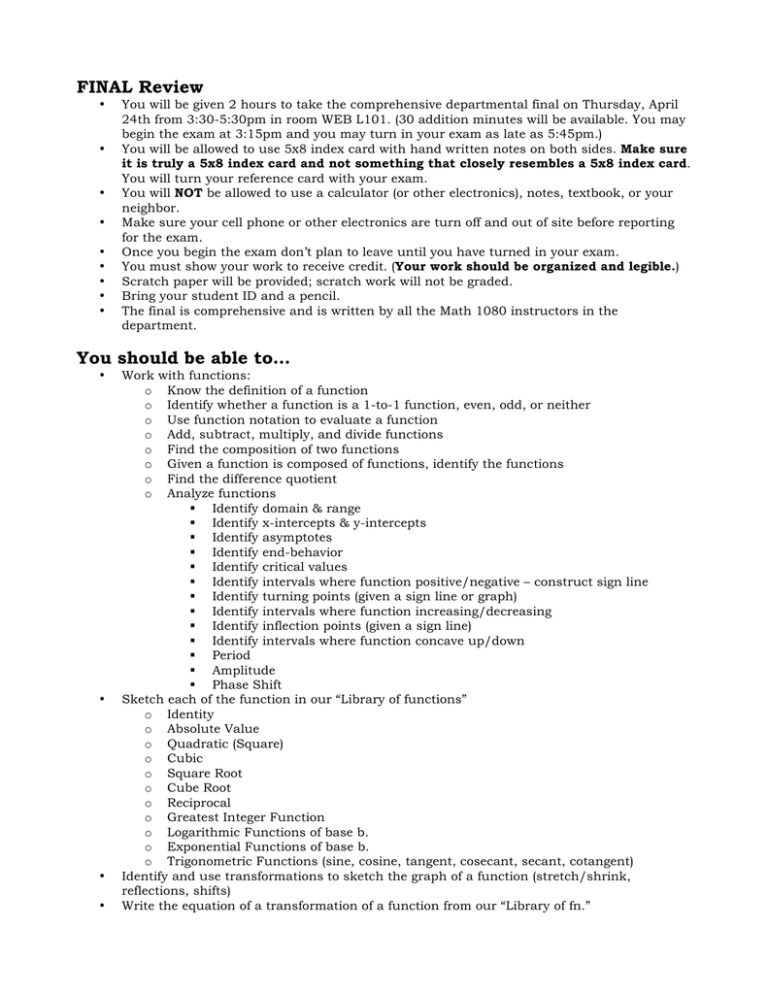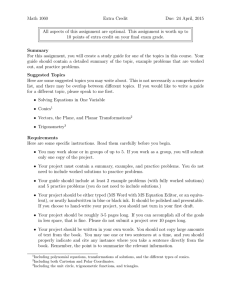FINAL Review
advertisement

FINAL Review • • • • • • • • • You will be given 2 hours to take the comprehensive departmental final on Thursday, April 24th from 3:30-5:30pm in room WEB L101. (30 addition minutes will be available. You may begin the exam at 3:15pm and you may turn in your exam as late as 5:45pm.) You will be allowed to use 5x8 index card with hand written notes on both sides. Make sure it is truly a 5x8 index card and not something that closely resembles a 5x8 index card. You will turn your reference card with your exam. You will NOT be allowed to use a calculator (or other electronics), notes, textbook, or your neighbor. Make sure your cell phone or other electronics are turn off and out of site before reporting for the exam. Once you begin the exam don’t plan to leave until you have turned in your exam. You must show your work to receive credit. (Your work should be organized and legible.) Scratch paper will be provided; scratch work will not be graded. Bring your student ID and a pencil. The final is comprehensive and is written by all the Math 1080 instructors in the department. You should be able to… • • • • Work with functions: o Know the definition of a function o Identify whether a function is a 1-to-1 function, even, odd, or neither o Use function notation to evaluate a function o Add, subtract, multiply, and divide functions o Find the composition of two functions o Given a function is composed of functions, identify the functions o Find the difference quotient o Analyze functions Identify domain & range Identify x-intercepts & y-intercepts Identify asymptotes Identify end-behavior Identify critical values Identify intervals where function positive/negative – construct sign line Identify turning points (given a sign line or graph) Identify intervals where function increasing/decreasing Identify inflection points (given a sign line) Identify intervals where function concave up/down Period Amplitude Phase Shift Sketch each of the function in our “Library of functions” o Identity o Absolute Value o Quadratic (Square) o Cubic o Square Root o Cube Root o Reciprocal o Greatest Integer Function o Logarithmic Functions of base b. o Exponential Functions of base b. o Trigonometric Functions (sine, cosine, tangent, cosecant, secant, cotangent) Identify and use transformations to sketch the graph of a function (stretch/shrink, reflections, shifts) Write the equation of a transformation of a function from our “Library of fn.” • • • • • • • • • • • • • • • • • • • • • • • • • • • • • • • Find the inverse of a function Write the equation of a line Rewrite a Quadratic equation in vertex form or standard form & identify the vertex Find the maximum or minimum of a function (especially a quadratic function) o Write the equation of a function to max. or min. from a “story” Divide Polynomials o Synthetic Division o Long Division o Understand Remainder Theorem Find Zeros of a Function o For Polynomials, know how to use each test (1) Rational Zeros Theorem (2) Upper and Lower Bound Theorem (3) Conjugate Pair Theorem (4) Descartes Rule of Sign Fundamental Theorem of Algebra (# of zeros) Leading Coefficient Test (end behavior) Multiplicity of Roots (even vs. odd) Root Location Theorem (related to Intermediate Value Theorem) Use the binomial theorem to expand a binomial Calculate n choose r without a calculator. Evaluate logarithmic and exponential expressions. Solve. (Also know when solutions are extraneous.) o Absolute value equations o Absolute value inequalities. o Nonlinear inequalities. o Polynomials equations o Rational equations o Radical equations o Logarithmic equations o Exponential equations o Trigonometric equations (principle value, on interval, or all solutions) o System of equations (both linear and nonlinear) Convert between radians and degrees Find the reference angle of a given angle Find coterminal angles of a given angle Evaluate trigonometric expressions exactly (including expressions involving inverse trigonometric functions) Rewrite or evaluate trigonometric expressions using identities The domain and range of the inverse trigonometric functions Solve triangles o Use the law of cosines and law of sines. (Identify whether given information about a triangle results in 0, 1, 2 or infinitely many triangles.) Find the area of a triangle Prove Trigonometric Identities Convert between rectangular and trigonometric form of complex numbers Multiply and Divide Complex numbers State DeMoivre’s theorem and use it to find all positive integer powers of a complex number State nth root theorem and use it to find all roots of a complex number Graph conic sections (parabolas, ellipses (and circles), hyperbolas) Identify conic sections from an equation Write conic sections in general form Write conic sections in standard form Understand what it means to be a solution of a system of equations Matrix arithmetic (add/subtract, scalar multiply, matrix multiply) Find the inverse of a matrix Use augmented matrix or matrix algebra (matrix equation) to solve a linear system • • • • • • Identify a sequence as arithmetic, geometric, Fibonacci-type or none of these Find a formula for the general term of an arithmetic or geometric sequence Calculate finite arithmetic or geometric series Calculate infinite geometric series Understand the difference between a sequence and a series Use summation notation Practice Problems: • • • • Midterms and Past Finals (posted on Canvas) Problems from the weekly quizzes Practice Problems listed on posted Midterm Review Sheets Other practice problems given out in class and posted on the class website Appendix D p. 660-661 #8, 16, 18, 25, 29, 33, 37, 39, 45 Ch. 6: p. 420 #11, 12, 14, 19, 25, 27, 28, 31-49odd Ch. 7: p. 492 (Self-Test) #1-3, 7-10 p. 493-495 (Practice for Calculus) #1-6, 9a, 11-18, 23-28, 29-37, 39, 41-44, 47, 49-55, 58 Ch. 8: p. 578 (Self-Test) #1, 3, 4, 6-9 p. 578-580 (Practice for Calculus) #13-20, 28-45, 52, 54



